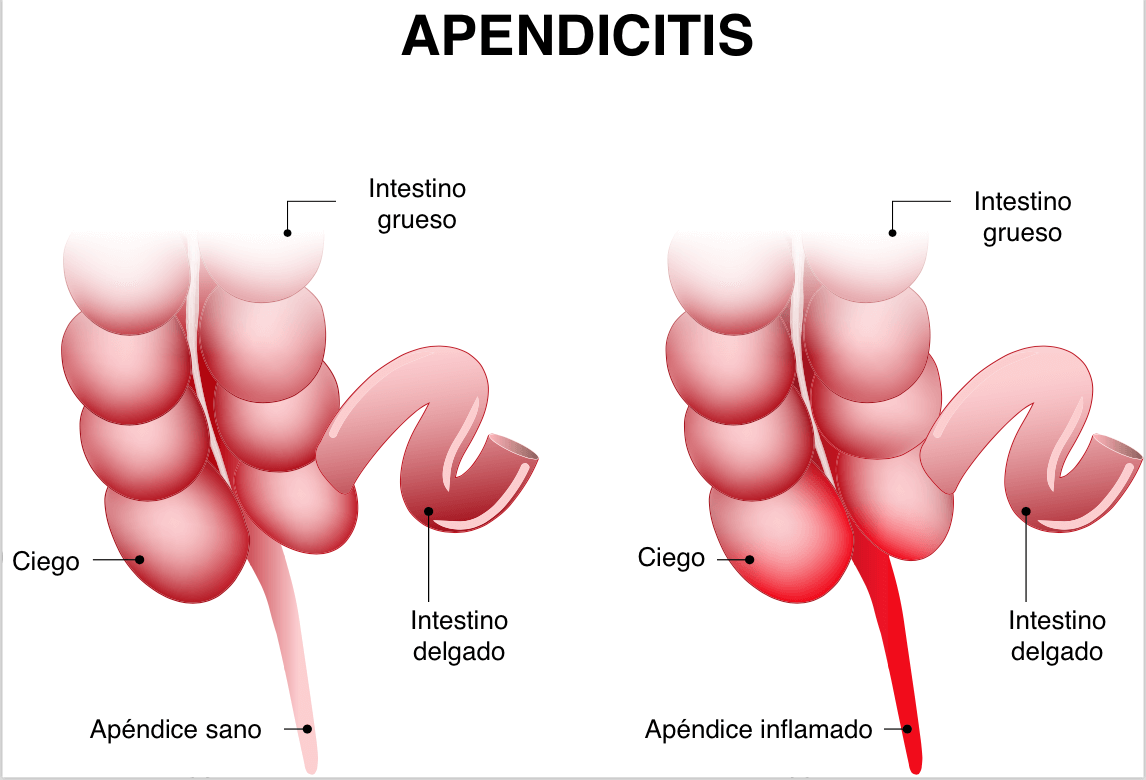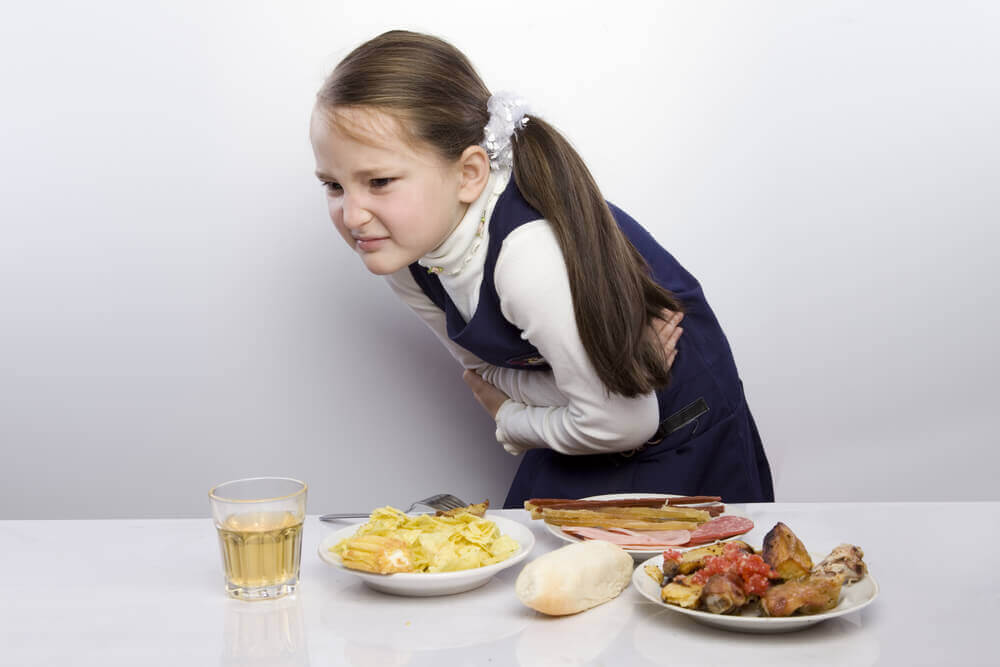Symptoms of Appendicitis in Children


Reviewed and approved by the doctor José Gerardo Rosciano Paganelli
Appendicitis is a common disease in children. It’s caused by the inflammation of the appendix, that small tubular structure that’s attached to the colon. Inflammation of the appendix is one of the most frequent causes of emergency abdominal surgery in children and adolescents.
It can occur in children and adolescents of all ages, although it rarely affects children under the age of two. The most common symptoms of appendicitis vary by age, but any doctor will be able to correctly diagnose it and make the decision whether or not to perform surgery.
What causes appendicitis?

Your appendix may become obstructed due to several reasons:
- The presence of hardened, dry fecal matter, known as fecalite;
- Inflammation of the lymph nodes in the intestines;
- The presence of parasites.
When your appendix is obstructed, it becomes inflamed and the first symptom appears: pain. When this occurs, bacteria begin to reproduce very rapidly. The appendix becomes infected and it can rupture if it’s not removed quickly, which seriously compromises the health – indeed, the life – of a child.
The Main symptoms of appendicitis in children
Just as the appendix can vary in size and location from one person to the next, there are variable symptoms of appendicitis in children. These symptoms are fairly common. Thus, they also might also come from other ailments, from simple indigestion to something more complex.
Not all of the following symptoms may occur. For that reason, see a doctor as soon as you notice a combination of them. They will have the experience to correctly diagnose the disease.
The appendix can rupture between 24 and 72 hours after the onset of symptoms, so appendicitis must be taken very seriously.
The most common symptoms
So, let’s talk about the most common symptoms of appendicitis in children.
1-Abdominal pain
This is the most common symptom, as pointed out in this study published in the Children Journal of Pediatrics. The pain will be located around the navel and then migrate to the lower right part of the abdomen.
It worsens under light pressure, with deep breathing, or while moving. There may also be stiffness in the abdominal muscles or pain when urinating or having a bowel movement.
See also: 6 signs of appendicitis that you should not ignore
2-Vomiting and loss of appetite
Dizziness, nausea, vomiting, and loss of appetiteusually occur together when a child is experiencing appendicitis, followed by fever, according to this paper published in the Mexican Journal of Pediatric Surgery. These symptoms are also common with other diseases. That’s why if there’s also pain present it could be related to appendicitis.

3-Fever
During the first hours of the disease a fever may be present, especially in children, although this isn’t common. A high fever may also appear when the inflammation has advanced and the appendix has ruptured, at which point any waste inside the organ has passed into the abdominal cavity.
Less frequent symptoms
5-Diarrhea or constipation
These symptoms aren’t common, but they do appear, according to an article in the journal Emergencias. Diarrhea won’t be excessive or very liquid. Rather, it will occur in small quantities and with mucus. Constipation may also occur, although it’s not typical.
6-Abdominal swelling
A swollen or distended abdomen can occur in the rare case when the patient is a young child or a baby.
How do symptoms vary according to age?

In children between the ages of five and 12, and as adolescents, the symptoms of appendicitis are similar to those of adults: Abdominal pain, vomiting, and loss of appetite.
- Appendicitis in children less than a year old is very rare. The main symptom here is abdominal swelling. The next common is vomiting and a loss of appetite. However, it’s difficult to determine if there’s pain because the child cannot point to it. Since the appendix in infants is so small, it’s difficult for obstruction and inflammation to occur.
- Similarly, appendicitis is rare in children between one and five years old. When it does occur, the main symptoms are pain, fever, and vomiting. We should also emphasize that if the abdomen is pressed, the child may complain of intense pain.
- For children between five and 12, the typical migration of the pain from the center of the abdomen to the lower right may not occur. Some of these patients develop a fever and very few experience diarrhea.
Also read: The warning signs of appendicitis.
The solution: Go to the doctor
Appendicitis can only be treated by removing the appendix surgically (appendectomy), a procedure with very few complications. An appendectomy is a common procedure and the patient will return home after two to three days in the hospital. There’s no home treatment or natural remedy to treat or reduce inflammation of the appendix.
If the infected appendix is not removed it can rupture and spread bacteria throughout the body. An infection caused by a ruptured appendix is very serious: it can form an abscess (a puss-filled infection) or spread throughout the abdomen (what is known as peritonitis).
Doctors are usually able to accurately diagnose appendicitis in children unless there’s an abnormal pain pattern or when a young child cannot describe their symptoms very well.
All cited sources were thoroughly reviewed by our team to ensure their quality, reliability, currency, and validity. The bibliography of this article was considered reliable and of academic or scientific accuracy.
- González, R. C. R., Alvarez, J. G., & Téllez, R. T. (2009). Apendicitis aguda: Revisión de la literatura. Revista del Hospital Juárez de México, 76(4), 210-216. https://www.medigraphic.com/pdfs/juarez/ju-2009/ju094g.pdf
- Beltrán, M., Almonacid, J., Gutiérrez, J., & Cruces, K. (2007). Puntuación diagnóstica de apendicitis aguda en niños realizada por pediatras de las Unidades de Emergencia. Revista chilena de pediatría, 78(6), 584-591. http://plataforma.revistachilenadepediatria.cl/index.php/rchped/article/view/2394/2188
- Vizueth-Ramírez, S., Romero-Montes, V. E., Olvera-Duran, J. Á., & Nava-Carrillo, A. D. (2005). Apendicitis en niños menores de cinco años. Revista Mexicana de Cirugía Pediátrica, 12(1), 11-15. https://www.medigraphic.com/pdfs/revmexcirped/mcp-2005/mcp051b.pdf
- Moreno, A., Garcia, A., & Marhuenda, C. (2013). APENDICITIS AGUDA EN PEDIATRIA. 2013. http://seattleclouds.com/myapplications/bpsl2011/appGUIAINFECCIONESv2iphoneipad/apendicitispediat.pdf
- Ronco, M. V., Arizkuren, E. M., Ojeda, E. G., Quirante, N. T., Landaluce, A. F., & Fernández, J. B. (2006). Apendicitis aguda en la infancia. Factores asociados al retraso diagnóstico. emergencias, 18, 151-155. https://www.researchgate.net/profile/Javier_Benito/publication/28113957_Apendicitis_aguda_en_la_infancia_Factores_asociados_al_retraso_diagnostico/links/0046351f77f9f5975e000000/Apendicitis-aguda-en-la-infancia-Factores-asociados-al-retraso-diagnostico.pdf
This text is provided for informational purposes only and does not replace consultation with a professional. If in doubt, consult your specialist.








